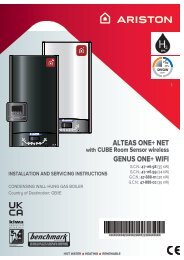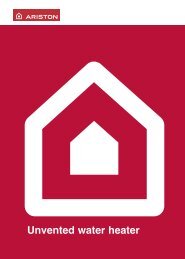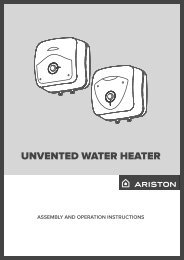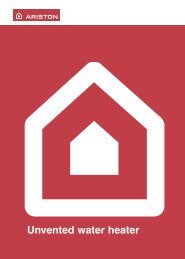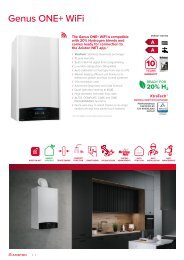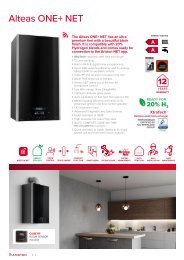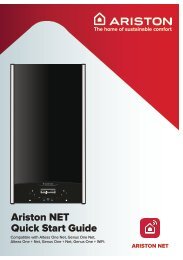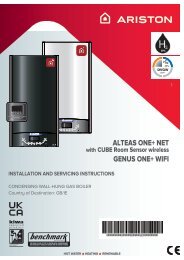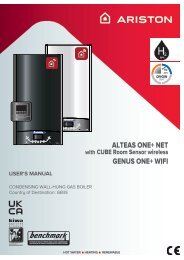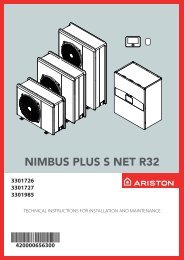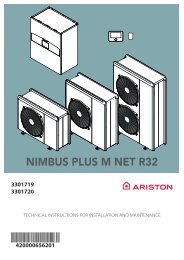Nimbus Compact M NET R32 Installation Manual UK
You also want an ePaper? Increase the reach of your titles
YUMPU automatically turns print PDFs into web optimized ePapers that Google loves.
<strong>Installation</strong><br />
3. <strong>Installation</strong><br />
3.1 Preliminary warnings<br />
i<br />
The appliance’s installation operations must be<br />
carried out exclusively by the Technical Assistance<br />
Service or by professionally qualified personnel<br />
according to the local regulations and<br />
laws.<br />
The outdoor unit uses a HFC R-32 (GWP 675) type eco-friendly<br />
liquid refrigerant, which does not deplete the ozone layer.<br />
Make sure that all the materials used for maintenance and for<br />
filling the components can be used with the R-32 refrigerant.<br />
(*) Global warming potential<br />
Refrigerant GWP (*)<br />
R-32 675<br />
This unit is filled in the factory with the amount of refrigerant<br />
shown on the data plate.<br />
If the circuit must be filled after maintenance or repairs, see the<br />
information appearing in this manual.<br />
The appliance must be filled with the refrigerant specified,<br />
namely R-32.<br />
a<br />
To prevent damages to the compressor, do not<br />
fill the circuit with a quantity of refrigerant exceeding<br />
the amount specified by the manufacturer.<br />
The canisters containing the R-32 refrigerant are equipped with<br />
a dip tube which allows liquid to flow out only when placed in<br />
a vertical position with the valve on top.<br />
The R-32 refrigerant, as occurs with all HFC refrigerants, is compatible<br />
only with oils recommended by the compressor manufacturer.<br />
POE-type oils rapidly absorb moisture. Do not expose the oil<br />
to the air.<br />
a<br />
a<br />
Never open the appliance when it is under a vacuum.<br />
Do not disperse the R-32 refrigerant into the environment.<br />
a<br />
– Ensure that all applicable national safety standards are<br />
observed throughout the course of the installation.<br />
– Ensure that the system is adequately earthed.<br />
– Ensure that the power supply voltage and frequency<br />
match those required by the outdoor unit, and that the<br />
installed power is sufficient for its operation.<br />
– Ensure that the power circuit impedance matches<br />
the electrical power absorbed by the outdoor unit,<br />
as shown on the rating plate of the outdoor unit (EN<br />
61000-3-12).<br />
– Ensure that residual-current devices and safety switches<br />
are adequately sized and connected to the outdoor and<br />
indoor units.<br />
Never use equipment other than that recommended<br />
by the manufacturer to speed up defrosting<br />
or for cleaning purposes.<br />
The appliances must be stored in a room without ignition<br />
sources operating continuously (for example: open flames, a<br />
running gas-fired device or a running electric heater).<br />
During tests, never raise the appliance’s pressure beyond the<br />
level recommended by the manufacturer.<br />
a<br />
a<br />
In the event of refrigerant leakages, immediately<br />
ventilate the area.<br />
Do not perforate or set afire to the appliance.<br />
Potential risks linked to refrigerant leakages:<br />
– Reduction of the oxygen in the installation zone<br />
– If the R-32 refrigerant comes into contact with flames, it<br />
can generate toxic gases.<br />
18 / EN







